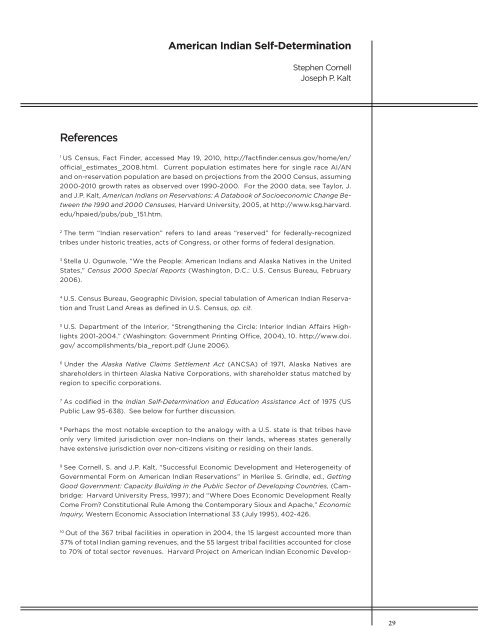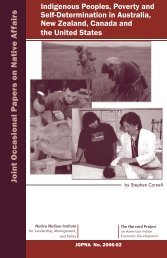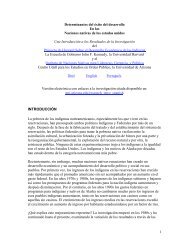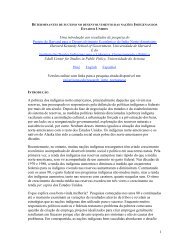American Indian Self-Determination - Native Nations Institute ...
American Indian Self-Determination - Native Nations Institute ...
American Indian Self-Determination - Native Nations Institute ...
- No tags were found...
Create successful ePaper yourself
Turn your PDF publications into a flip-book with our unique Google optimized e-Paper software.
<strong>American</strong> <strong>Indian</strong> <strong>Self</strong>-<strong>Determination</strong>Stephen CornellJoseph P. KaltReferences1US Census, Fact Finder, accessed May 19, 2010, http://factfinder.census.gov/home/en/official_estimates_2008.html. Current population estimates here for single race AI/ANand on-reservation population are based on projections from the 2000 Census, assuming2000-2010 growth rates as observed over 1990-2000. For the 2000 data, see Taylor, J.and J.P. Kalt, <strong>American</strong> <strong>Indian</strong>s on Reservations: A Databook of Socioeconomic Change Betweenthe 1990 and 2000 Censuses, Harvard University, 2005, at http://www.ksg.harvard.edu/hpaied/pubs/pub_151.htm.2The term “<strong>Indian</strong> reservation” refers to land areas “reserved” for federally-recognizedtribes under historic treaties, acts of Congress, or other forms of federal designation.3Stella U. Ogunwole, “We the People: <strong>American</strong> <strong>Indian</strong>s and Alaska <strong>Native</strong>s in the UnitedStates,” Census 2000 Special Reports (Washington, D.C.: U.S. Census Bureau, February2006).4U.S. Census Bureau, Geographic Division, special tabulation of <strong>American</strong> <strong>Indian</strong> Reservationand Trust Land Areas as defined in U.S. Census, op. cit.5U.S. Department of the Interior, “Strengthening the Circle: Interior <strong>Indian</strong> Affairs Highlights2001-2004.” (Washington: Government Printing Office, 2004), 10. http://www.doi.gov/ accomplishments/bia_report.pdf (June 2006).6Under the Alaska <strong>Native</strong> Claims Settlement Act (ANCSA) of 1971, Alaska <strong>Native</strong>s areshareholders in thirteen Alaska <strong>Native</strong> Corporations, with shareholder status matched byregion to specific corporations.7As codified in the <strong>Indian</strong> <strong>Self</strong>-<strong>Determination</strong> and Education Assistance Act of 1975 (USPublic Law 95-638). See below for further discussion.8Perhaps the most notable exception to the analogy with a U.S. state is that tribes haveonly very limited jurisdiction over non-<strong>Indian</strong>s on their lands, whereas states generallyhave extensive jurisdiction over non-citizens visiting or residing on their lands.9See Cornell, S. and J.P. Kalt, “Successful Economic Development and Heterogeneity ofGovernmental Form on <strong>American</strong> <strong>Indian</strong> Reservations” in Merilee S. Grindle, ed., GettingGood Government: Capacity Building in the Public Sector of Developing Countries, (Cambridge:Harvard University Press, 1997); and “Where Does Economic Development ReallyCome From? Constitutional Rule Among the Contemporary Sioux and Apache,” EconomicInquiry, Western Economic Association International 33 (July 1995), 402-426.10Out of the 367 tribal facilities in operation in 2004, the 15 largest accounted more than37% of total <strong>Indian</strong> gaming revenues, and the 55 largest tribal facilities accounted for closeto 70% of total sector revenues. Harvard Project on <strong>American</strong> <strong>Indian</strong> Economic Develop-29







